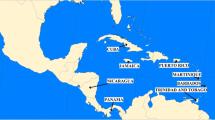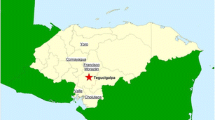Abstract
Between November 1979 and December 1991, 398 cases of severe leptospirosis were confirmed on Barbados (range for 1980–1991 23–56; mean 32.7; incidence 13.3/100,000/year). For the six-year periods 1980–1985 and 1986–1991 there was no significant change in incidence with time. Incidence is unlikely to change significantly in the next decade. Monthly average case numbers ranged from 1.4 (July) to 4.3 (November). The average (2.8) for June to December (the 7 wetter months) was not significantly higher than that (2.5) for January to May (the 5 drier months). The age range was 7–86. There were three times as many male cases (302) as female (96), and nearly 10 times as many in those <35. Although the highest number of cases (69) was in males aged 15–24, the highest incidence was in the older age groups, particularly the male 65–74 year-olds, and the female 55–64 year-olds. Leptospirosis was the proven cause of death in 55 (13.8%) hospital patients (annual range 0–13, mean 4.5). Some of a further 39 fatalities might have been cases. Death from leptospirosis was nearly twice as common among the women as among the men. Only one patient under 20 years of age died.Leptospira were isolated and identified from 117 (29.4%) of the 398 sick patients. The infecting organisms werebim (serogroup Autumnalis — 75),copenhageni (Icterohaemorrhagiae — 26),arborea (Ballum — 14) andbajan (Australis — 2). These infecting serovars could not be distinguished clinically, but infection was milder in children than in adults. Despite its predominance in surveyed children, serogroup Panama was virtually absent in this study. Rainfall is the major factor affecting the distribution of cases; not surprisingly, sanitation workers and agricultural workers appear to be the groups at highest risk. The general lack of clear-cut risk factors reflects the ubiquity of leptospires in the environment and the fact that the disease is not entirely occupational.
Similar content being viewed by others
References
Agriculture Census. Barbados: Ministry of Agriculture, Food and Fisheries, 1989.
Alexander AD. The distribution of leptospirosis in Latin America. Bull WHO 1960; 23: 113–125.
Alexander AD, Benenson AS, Byrne RJ, et al. Leptospirosis in Puerto Rico. Zoon Res 1963; 2: 153–227.
Baulu J, Everard COR, Everard JD. Leptospires in vervet monkeys (Cercopithecus aethiops sabaeus) in Barbados. J Wildl Dis 1987; 23: 60–66.
Bayley HH. An investigation of the infectious jaundice of Barbados. Carib Med J 1939; 1: 135–142.
Bayley HH. An investigation of Weil's disease on Barbados. MD Thesis, University of Cambridge, UK, 1942, 57 pp.
Bennett S, Everard COR. Absence of epidemicity of severe leptospirosis in Barbados. Epidemiol Infect 1991; 106: 151–156.
Bras G. Leptospirosis in Jamaica: Case report. WI MedJ 1955; 4: 126–128.
Census. West Indian Census 1946 Part C. Census of population of the Colony of Barbados, 1946.
Census of Population in the Commonwealth Caribbean-Barbados 1980, Government of Barbados, 1985.
Census of Population in the Commonwealth Caribbean-Barbados 1990, Government of Barbados, 1993.
Cole JR, Sulzer CR, Pursell AR. Improved microtechnique for the leptospiral microscopic agglutination test. Appl Microbiol 1973; 25: 976–980.
Damude DF, Jones CJ, Myers DM. A study of leptospirosis among animals in Barbados WI. Trans Roy Soc Trop Med Hyg 1979; 73: 161–168.
Damude DF, Jones CJ, White H St.C, Myers DM. The problem of human leptospirosis in Barbados. Trans Roy Soc Trop Med Hyg 1979; 73: 169–177.
Edwards CN, Everard COR. Hyperamylasemia and pancreatitis in leptospirosis. Am J Gastroenterol 1991; 86: 1665–1668.
Edwards CN, Nicholson GD, Hassell TA, Everard COR, Callender J. Thrombocytopenia in leptospirosis: The absence of disseminated intravascular coagulation. Am J Trop Med Hyg 1986; 35: 356–358.
Edwards CN, Nicholson GD, Hassell TA, Everard COR, Callender J. Penicillin therapy in icteric leptospirosis. Am J Trop Med Hyg 1988; 39: 388–390.
Edwards CN, Nicholson GD, Hassell TA, Everard COR, Callender J. Leptospirosis in Barbados: A clinical study. WI Med J 1990; 39: 27–34.
Everard COR, Bennett S, Edwards CN, Nicholson GD, Hassell TA, Carrington DG, Everard JD. An investigation of some risk factors for severe leptospirosis on Barbados. J Trop Med Hyg 1992; 95: 13–22.
Everard COR, Carrington DG, Korver H, Burke R, Everard JD, Gravekamp C. Leptospires in the whistling frog (Eleutherodactylus johnstonei) on Barbados. J Trop Med Hyg 1990; 93: 140–145.
Everard COR, Carrington DG, Korver H, Everard JD. Leptospires in the marine toad (Bufo marinus) on Barbados. J Wildl Dis 1988; 24: 334–338.
Everard COR, Edwards CN, Webb GB, White H St.C, Nicholson GD. The prevalence of severe leptospirosis among humans on Barbados. Trans Roy Soc Trop Med Hyg 1984; 78: 596–603.
Everard COR, Fraser-Chanpong GM, Bhagwandin L, Race MW, James A. Leptospires in wildlife from Trinidad and Grenada. J Wildl Dis 1983; 19: 192–199.
Everard COR, Hayes RJ, Edwards CN. Leptospiral infection in school-children from Trinidad and Barbados. Epidemiol Infect 1989; 103: 143–156.
Everard COR, Jones CJ, Inniss VA, Carrington DG, Vaughan AW. Leptospirosis in dogs on Barbados. Israel J Vet Med 1987; 43: 288–295.
Everard COR, Maude GH, Hayes RJ. Leptospiral infection: A household serosurvey in urban and rural communities in Barbados and Trinidad. Ann Trop MedParasit 1990; 84: 255–256.
Everard COR, Sulzer CR, Bhagwandin LJ, Fraser-Chanpong GM, James AC. PathogenicLeptospira isolates from the Caribbean islands of Trinidad, Grenada and St Vincent. Int J Zoon 1980; 7: 90–100.
Everard JD, Everard COR. Leptospirosis in the Caribbean. Rev Med Microbiol 1993; 3: 114–122.
Faine S, ed. Guidelines for the control of leptospirosis. WHO Offset Publ. No. 67. Geneva: WHO, 1982.
Floch H, Raba A. Les leptospiroses en Guyane Franchise et dans la Region Caribe. Rev Path Gen Comp 1954; 54: 834–843.
Gale DA, Everard COR, Carrington DG, Everard JD. Leptospiral antibodies in patients from a Barbadian general practice. Eur J Epidemiol 1990; 6: 150–155.
Guiliani S. Informe Annual del Departamento de Sanidad de Puerto Rico, 1917–1918. San Juan: Negociado de Imprenta y Transporte, 1918.
Guiteras J, Lebredo MG, Hoffmann GH. Sanidad Benefic municipal 1921; 26: 39.
Hassell TA, Edwards CN, Nicholson GD, Everard COR. Non-invasive determination of the cardiovascular consequences of leptospirosis. WI Med J 1985; 34 (suppl): 53.
Hudson C. Production of sugar and yields of cane in Barbados: Trends in recent times and possible explanations. 8th Annual Barbados Sugar Technologists Ass Conf Bull, 1988.
Jolly A, Danglemont F. Sur un cas de maladie de Weil a la Guadeloupe. Bull Soc Path Exot 1937; 30: 557–562.
Jones CJ. Preliminary report on the isolation of twelveLeptospira serotypes in Barbados. WI Med J 1974; 23: 65–68.
Jones CJ, Sulzer KR, Everard COR, Vaughan AW, Iniss VA.Bim, a new serovar of Leptospira interrogans isolated from a dog in Barbados. J Clin Microbiol 1984; 19: 946.
Jones CJ, Taylor KD, Myers DM, Turner LH, Everard COR. PathogenicLeptospira isolates from the Caribbean island of Barbados. Int J Zoon 1982; 9: 138–146.
Koppisch E, Suárez RM, Kohlschütter E, Hernández Morales F. Weil's disease in Puerto Rico: Report of five cases, one of them with post-mortem findings. Puerto Rico J Publ Health Trop Med 1942; 17: 305–331.
Laroche V. La leptospirose humaine en Haiti. Bol Ofic Sanit Panam 1965; 59: 414–422.
Leger M. Spirochetose ictero-hemorragique à la Guadeloupe. Bull Soc Path Exot 1932; 25: 304–306.
LL. Unpublished records, documents and annual reports of the Barbados Leptospira Laboratory, 1979–1981.
Montestruc E. Leptospiroses icterigènes et non icterigènes à la Martinique. Bull Off Int Hyg Publ 1939; 31: 1464–1472.
Myers DM, Jones CJ.Leptospira fort-bragg isolated from a rat in Barbados. Bull Panam Hlth Org 1975; 9: 208–211.
Nicholson GD, Edwards CN, Hassell TA, Everard COR, Callender J. Urinary diagnostic indices in the management of leptospirosis: Selection of patients for dialysis therapy. WI Med J 1989; 38: 33–38.
Pawan JL.Leptospira ictero-haemorrhagiae in rats in Trinidad, B WI. Ann Trop Med Parasit 1931; 25: 31–33.
Sulzer CR, Jones WL. Leptospirosis: Methods in laboratory diagnosis. Atlanta, GA: US Public Health Service, Center for Disease Control, CDC Publ. No. 79-8275, 1978, 40 pp.
Taylor KD. The rodent and monkey problem in Barbados (Appendix 4). Cyclostyled report to the UK Ministry of Overseas Development, 1965, 52 pp.
Taylor KD, Turner LH, Everard JD. Leptospires inRattus spp. on Barbados. J Trop Med Hyg 1991; 94: 102–103.
Terpstra WJ, Korver H, Van Leeuwen J, Klatser PR, Kolk AHJ. The classification of Sejroe group serovars ofLeptospira interrogans with monoclonal antibodies. Zbl Bakt Hyg Abt A 1985; 259: 498–506.
Terpstra WJ, Ligthart G, Schoone GJ. Serodiagnosis of human leptospirosis by enzyme-linked immunosorbent-assay (ELISA). Zbl Bakt Hyg Abt A 1980; 247: 400–405.
Terpstra WJ, Ligthart GS, Schoone GJ. ELISA for the detection of specific IgM and IgG in human leptospirosis. J Gen Microbiol 1985; 131: 377–385.
Author information
Authors and Affiliations
Rights and permissions
About this article
Cite this article
Everard, C.O.R., Edwards, C.N., Everard, J.D. et al. A twelve-year study of leptospirosis on Barbados. Eur J Epidemiol 11, 311–320 (1995). https://doi.org/10.1007/BF01719436
Accepted:
Issue Date:
DOI: https://doi.org/10.1007/BF01719436




